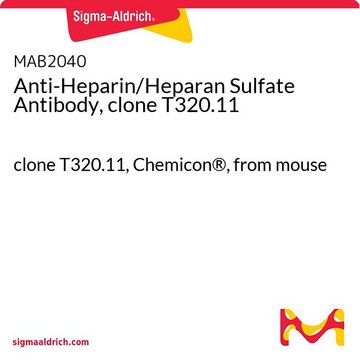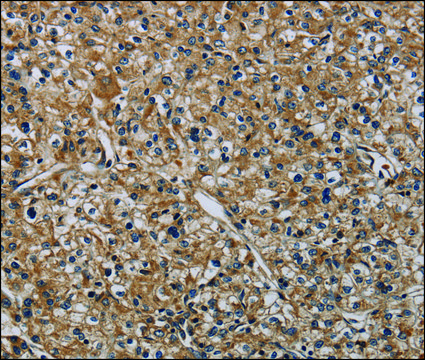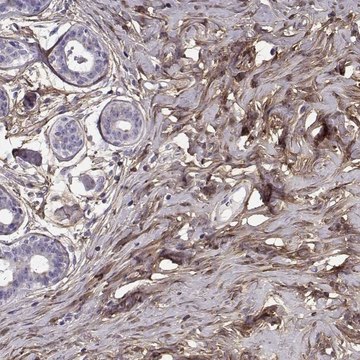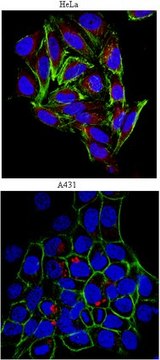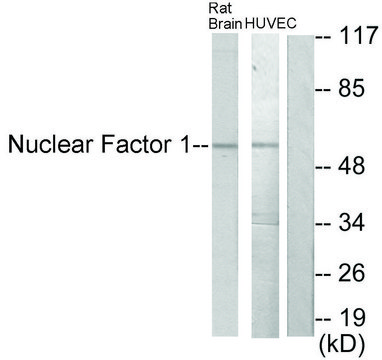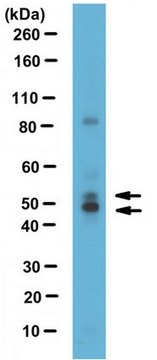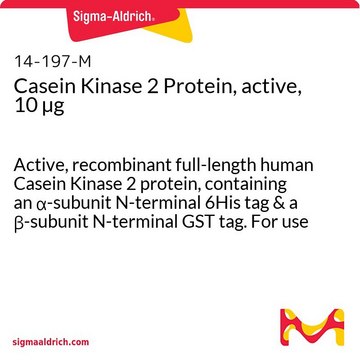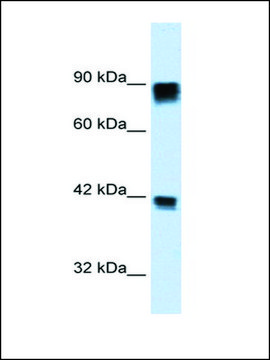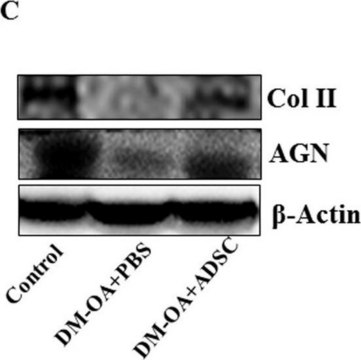推荐产品
生物来源
mouse
质量水平
偶联物
unconjugated
抗体形式
purified antibody
抗体产品类型
primary antibodies
克隆
780-3, monoclonal
种属反应性
human
包装
antibody small pack of 100 μg
技术
electron microscopy: suitable
flow cytometry: suitable
immunofluorescence: suitable
western blot: suitable
同位素/亚型
IgMκ
表位序列
Unknown
Protein ID登记号
Unknown
运输
dry ice
靶向翻译后修饰
unmodified
一般描述
Most eukaryotic genes are expressed as pre-mRNAs that are converted to mRNA by splicing. In this process noncoding sequences (introns) are removed, and coding sequences (exons) are ligated together. Some exons are known to be constitutively spliced and are present in every mRNA produced from a given pre-mRNA. However, many are alternatively spliced to generate variable forms of mRNA from a single pre-mRNA species. Nuclear pre-mRNA splicing is catalyzed by the spliceosome that is a multi-megadalton ribonucleoprotein (RNP) complex. It removes introns from nuclear pre-mRNA. The conformation and composition of spliceosome is shown to be dynamic, which is critical for its high degree of accuracy and flexibility. In most eukaryotes two unique spliceosomes have been described: the U2 -dependent spliceosome that catalyzes the removal of U2-type of introns and the U12-dependent spliceosome that is present only in a subset of eukaryotes and splices U12-type of intron. Introns are removed by two consecutive transesterification reactions. In the first reaction the 2 OH group of the branch adenosine of the intron carries out a nucleophilic attack on the 5 ss, which results in cleavage at this site and ligation of the 5 end of the intron to the branch adenosine, forming a lariat structure. In the second reaction, the 3 ss is attacked by the 3 OH group of the 5 exon, which leads to the ligation of the 5 and 3 exons forming the mRNA, and release of the intron. (Ref.: Matera, AG., and Wang, Z. (2014). Nat. Rev. Mol. Cell Biol. 15(2); 108-121; Will, CL., and Luhrmann, R. (2011). Cold Spring Harb. Perspect. Biol. 3(7); a003707; Patel, AA., and Steitz, JA. (2003). Nat. Rev. Mol. Cell Biol. 4(12); 960-970).
特异性
Clone 780-3 is a mouse monoclonal antibody that detects human Nuclear spliceosomes.
免疫原
Nuclear preparation from U266 human myeloma cells.
应用
Quality Control Testing
Evaluated by Flow Cytometry in permeabilized HeLa cells.
Flow Cytometry Analysis: 2 μg of this antibody detected Nuclear Spliceosomes in one million permeabilized HeLa cells.
Tested Applications
Flow Cytometry Analysis: A representative lot detected Nuclear Spliceosomes in Flow Cytometry applications (Clevenger, C.V., et al. (1985). Cytometry. 6(3): 208-14; Bauer, K.D., et al. (1986). Cancer Res. 46(5): 2428-34; Clevenger, C.V., et al. (1987). Cytometry. 8(3): 280-6).
Immunofluorescence Analysis: A representative lot detected Nuclear Spliceosomes in Immunofluorescence applications (Clevenger, C.V., et al. (1984). J Histochem Cytochem. 32(7): 757-65; Clevenger, C.V., et al. (1985). Cytometry. 6(3): 208-14; Bauer, K.D., et al. (1986). Cancer Res. 46(5): 2428-34; Clevenger, C.V., et al. (1987). Cytometry. 8(3):280-6; Clevenger, C.V., et al. (1987). Cytometry. 8(3): 280-6).
Western Blotting Analysis: A representative lot detected Nuclear Spliceosomes in Western Blotting applications (Clevenger, C.V., et al. (1987). Cytometry. 8(3): 280-6; Kumar, P., et al. (2012). PLoS One. 7(8): e42712).
Electron Microscopy: A representative lot detected Nuclear Spliceosomes in Electron Microscopy applications (Clevenger, C.V., et al. (1984). J Histochem Cytochem. 32(7): 757-65; Bauer, K.D., et al. (1986). Cancer Res. 46(5): 2428-34; Clevenger, C.V., et al. (1987). Cytometry. 8(3): 280-6).
Note: Actual optimal working dilutions must be determined by end user as specimens, and experimental conditions may vary with the end user
Evaluated by Flow Cytometry in permeabilized HeLa cells.
Flow Cytometry Analysis: 2 μg of this antibody detected Nuclear Spliceosomes in one million permeabilized HeLa cells.
Tested Applications
Flow Cytometry Analysis: A representative lot detected Nuclear Spliceosomes in Flow Cytometry applications (Clevenger, C.V., et al. (1985). Cytometry. 6(3): 208-14; Bauer, K.D., et al. (1986). Cancer Res. 46(5): 2428-34; Clevenger, C.V., et al. (1987). Cytometry. 8(3): 280-6).
Immunofluorescence Analysis: A representative lot detected Nuclear Spliceosomes in Immunofluorescence applications (Clevenger, C.V., et al. (1984). J Histochem Cytochem. 32(7): 757-65; Clevenger, C.V., et al. (1985). Cytometry. 6(3): 208-14; Bauer, K.D., et al. (1986). Cancer Res. 46(5): 2428-34; Clevenger, C.V., et al. (1987). Cytometry. 8(3):280-6; Clevenger, C.V., et al. (1987). Cytometry. 8(3): 280-6).
Western Blotting Analysis: A representative lot detected Nuclear Spliceosomes in Western Blotting applications (Clevenger, C.V., et al. (1987). Cytometry. 8(3): 280-6; Kumar, P., et al. (2012). PLoS One. 7(8): e42712).
Electron Microscopy: A representative lot detected Nuclear Spliceosomes in Electron Microscopy applications (Clevenger, C.V., et al. (1984). J Histochem Cytochem. 32(7): 757-65; Bauer, K.D., et al. (1986). Cancer Res. 46(5): 2428-34; Clevenger, C.V., et al. (1987). Cytometry. 8(3): 280-6).
Note: Actual optimal working dilutions must be determined by end user as specimens, and experimental conditions may vary with the end user
Anti-Nuclear Spliceosomes, clone 780-3, Cat. No. MAB1286-I, is a mouse monoclonal antibody that detects Nuclear spliceosomes and is tested for use in Electron Microscopy, Flow Cytometry, Immunofluorescence, and Western Blotting.
外形
Purified mouse monoclonal antibody IgM in PBS without preservatives.
储存及稳定性
Store at -10°C to -25°C. Handling Recommendations: Upon receipt and prior to removing the cap, centrifuge the vial and gently mix the solution. Aliquot into microcentrifuge tubes and store at -20°C. Avoid repeated freeze/thaw cycles, which may damage IgG and affect product performance.
其他说明
Concentration: Please refer to the Certificate of Analysis for the lot-specific concentration.
免责声明
Unless otherwise stated in our catalog or other company documentation accompanying the product(s), our products are intended for research use only and are not to be used for any other purpose, which includes but is not limited to, unauthorized commercial uses, in vitro diagnostic uses, ex vivo or in vivo therapeutic uses or any type of consumption or application to humans or animals.
未找到合适的产品?
试试我们的产品选型工具.
储存分类代码
12 - Non Combustible Liquids
WGK
WGK 2
闪点(°F)
Not applicable
闪点(°C)
Not applicable
法规信息
新产品
我们的科学家团队拥有各种研究领域经验,包括生命科学、材料科学、化学合成、色谱、分析及许多其他领域.
联系技术服务部门